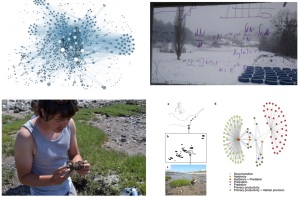Community Ecology
What factors drive the observed patterns in biological communities? How do these patterns change at different spatial and/or temporal scales? What mechanism(s) explain this variation? Our research investigates the spatial structure of species interaction networks at both local and regional scales and their effects on ecosystem functioning, as well as the historical drivers of the structure of contemporary and ancient ecological networks. Most research in ecological networks relies on static snapshots of species interactions. Yet, communities are dynamic, and species interactions are forged and broken up over the assembly process or following disturbances (dis-assembly). These dis(assembly) dynamics likely have considerable effects on the functioning and stability of ecosystems. We explore how and why the structural properties of biological communities change along environmental gradients, as well as the changes in the functioning and stability of complex ‘networks of networks’

Examples: Galiana et al. (Nature Ecology & Evolution In press); Hackett et al. (Ecology Letters 2019); Lurgi et al. (Theoretical Ecology 2016); Montoya et al. (Nature Communications 2015); Montoya et al. (Global Ecology & Biogeography 2014)
Global change effects in communities and ecosystems
Ecosystems worldwide are experiencing the consequences of global change, including those related to climatic warming, landscape management and the destruction and fragmentation of natural habitats. These factors erode biodiversity and change biological communities and ecosystem processes that are ultimately responsible for the ecosystem services that nature provides to humans. To forecast and mitigate these effects is the environmental challenge of our age. We use a combination models, large empirical datasets and empirical work to explore the response of communities and ecosystems to climate change, biological invasions and habitat destruction.

Examples: McWilliams et al. (Nature Communications 2019); Montoya (Journal of Animal Ecology 2021); Emer et al. (Diversity & Distributions 2016); Russo et al. (Ecology 2014); Nenzen et al. (PLoS ONE 2014); Montoya et al (Oikos 2010); Montoya et al (Science 2008); Montoya et al. (Ecography 2007)
Agroecology
Ecosystems generate services on which humans depend directly or indirectly, such as biomass production, climate regulation, pollination, and biotic control. One challenge is to understand and predict how biodiversity changes will affect the delivery of these ecosystem services. We are interested in unraveling the dynamics of the relationships between biodiversity and ecosystem functioning. We also study synergies and trade-offs between multiple ecosystem services, e.g. crop production, crop pollination and biodiversity, in heterogeneous landscapes. This framework is applied to find solutions to our current agricultural system so that food production, biodiversity and biodiversity-based ecosystem services can be simultaneously promoted.

Examples: Montoya et al. (Journal of Ecology 2021); Montoya et al. (Ecological Modelling 2020); Montoya, D. (Ecological Applications 2019)
Restoration ecology
Scientific research has advanced our knowledge of the impacts of global change on ecosystems. Comparatively, however, it remains unclear how ecosystem assemble and recover after perturbations. This is in part due to the fact that most studies investigating assembly and recovery dynamics focus on single aspects of ecosystems (species richness, species interactions and single fluxes of matter or energy), hindering our understanding of the general relationships and feedbacks between the structure, functioning and stability of ecosystems. Thus, restoration ecology still lacks a sound, generalized theoretical foundation based on community and ecosystems ecology theory (e.g. food webs, metacommunities and metaecosystems, biodiversity-ecosystem functioning). To fully understand these relationships and how they change along recovery gradients, studies which encompass several aspects of biodiversity and ecosystem functioning simultaneously are needed. Our work aims to use models, datasets and field experiments, to investigate ecosystem recovery dynamics, to identify the factors that lead (and do not lead) to successful ecosystem recovery and, more generally, to move restoration ecology from a site- and situation-specific discipline to a more globally applicable science.

Examples: Montoya, D. (One Earth 2021); Moreno-Mateos et al. (Nature Ecology & Evolution 2020); Montoya, D. (Ecosistemas 2019) ; Jones et al. (Proceeding of the Royal Society of London B 2018, 2019); Moreno-Mateos et al. (Nature Communications 2017); Montoya et al. (Trends in Ecology & Evolution 2012); Riberiro et al. (Restoration Ecology 2015); Meli et al. (PLoS ONE 2017)